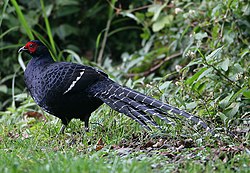Mikado pheasant
| Mikado pheasant | |
|---|---|
 |
|
| Male | |
| Scientific classification | |
| Kingdom: | Animalia |
| Phylum: | Chordata |
| Class: | Aves |
| Order: | Galliformes |
| Family: | Phasianidae |
| Subfamily: | Phasianinae |
| Genus: | Syrmaticus |
| Species: | S. mikado |
| Binomial name | |
|
Syrmaticus mikado Ogilvie-Grant, 1906 |
|
| Synonyms | |
|
Calophasis mikado |
|
Calophasis mikado
The Mikado pheasant (Syrmaticus mikado) is a gamebird in the pheasant family Phasianidae of the order Galliformes, gallinaceous birds. Sometimes considered an unofficial national bird of Taiwan (along with the Swinhoe's pheasant and Taiwan blue magpie), a pair of Mikado pheasants and Yushan National Park, one of the areas it is known to inhabit, is depicted in the 1000 dollar bill of the Taiwanese dollar.
The Mikado pheasant is endemic to mountainous regions of Taiwan. The species occupies dense shrubs, bamboo growth and grassy terrain with conifer overstory in central and southern Taiwan, from 2000 to 3200 meters above sea level.
With the tail included, male of this species get to be up to 70 cm in body length, while the smaller females measure up to 47 cm. The male is dark with plumage that refracts with blue or violet iridescence, with white stripes on its wings and tail. The female is brown and specked with brown and white quills. The long and striped tail feathers of the male were used by the Taiwanese aborigines as a head-dress decoration. The type specimen of the pheasant comprises two such tail feathers obtained in 1906 by collector Walter Goodfellow from the head-dress of one of his porters. It was named in honour of the Emperor of Japan, of which Taiwan was occupied by. Its Chinese name, 帝雉 (dizhi) also translates to "Emperor Pheasant."
The pheasants will often come out into the open either in light rain or after heavy rain, where the mist conceals them. They tend to be solitary or found in pairs, often quiet, yet alert. They can usually tolerate the presence of humans and it is possible to observe them up close, especially in areas where they have become habituated to humans feeding them. When disturbed, they will slowly and cautiously seek out shelter within surrounding vegetation, rather than fluttering away in panic. If desperate, they will fly short distances, gliding down the mountainside. The males are territorial, with a range of 200–400 metres in radius. Both sexes make soft clucking sounds when feeding, and the males make ke, ke, ke calls when fighting for their mate or territory. Both sexes may perform a wing-whirring display, and during the breeding season the male performs a lateral running display with his body expanded and tail fanned.
...
Wikipedia

